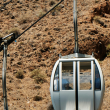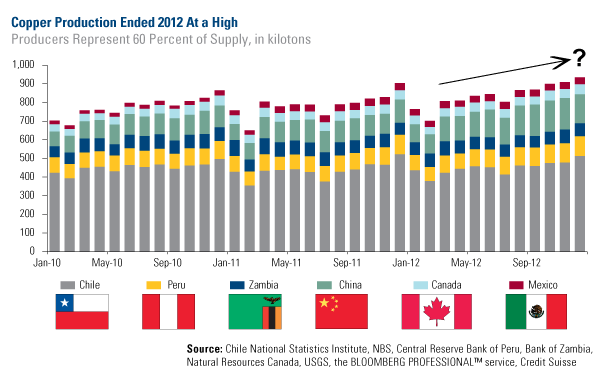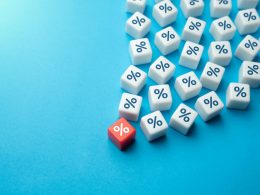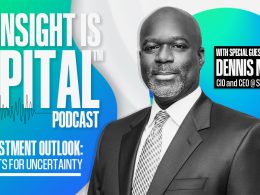April 12, 2013
How a Landslide Shifts Copper Supply
By Frank Holmes, CEO and Chief Investment Officer, U.S. Global Investors
The U.S. mining industry was dealt a devastating blow as Kennecott Utah Copper’s Bingham Canyon Mine experienced a pit wall failure causing a massive landslide with rocks and dirt covering the bottom of the mine pit. It’s a miracle no one was hurt due to the vigilance of its owner, Rio Tinto.
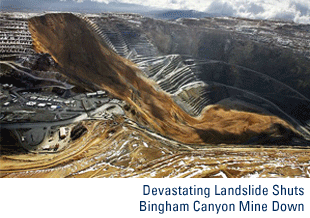
Brian Hicks, portfolio manager of the Global Resources Fund, is very familiar with the mine, having visited it often. He also has personal ties as both of his grandfathers were once employed by the mine. When Brian saw the photo of the landslide posted on the web, he said the substantial destruction of the collapsed wall and falling rock was apparent, yet the tremendous scale and magnitude of the mine cannot be captured in pixels.
Bingham’s immense size is a powerful sight to witness firsthand. It is one of the largest open-pit copper mines in the world, it’s the second largest copper producer in the U.S., and it’s been in operation for more than one hundred years.
The mine supplies about 1 percent of copper to the global market, says research firm Paradigm Capital. In the fourth quarter, the mine produced 59,000 tons and 163,000 tons in 2012. Because of the landslide, analysts expect there to be a huge decline in the overall copper output from Bingham this year.
This is a short-term setback for Rio Tinto, as the mine is one of four main copper assets for the company, but Nomura sees an additional shift in the copper market, “where this could take a market where many observers felt a meaningful surplus was about to emerge, back to remaining quite tight” in 2013.
Copper production had been rising to a new high, as you can see below. Credit Suisse charts the rising supply of copper coming out of Canada, Chile, China, Mexico, Peru and Zambia, which represents 60 percent of global supply. In the fourth quarter of 2012 only, copper in the top 6 countries increased 8.5 percent on a year-over-year basis.
With production higher, copper has moved from a deficit to a balanced market, which is typical, but “this is not to say that persistent growth of new mine supply is not problematic for a variety of technical and other reasons,” says Credit Suisse. In addition to the setback from Brigham, the new mines under development, including one in Mongolia, might not come on line as quickly as one thinks.
Copper mining has always been dealt more than its fair share of challenges: We’ve discussed labor disputes in the past, such as the massive strike in Grasberg in Indonesia, which significantly reduced production from a pre-disruption level of about 500 to 700 tons to 136 tons in a year, says Credit Suisse. Political issues and weather catastrophes have also hurt copper supply in recent years.
The good news is that demand for copper persists. With four babies born every second, a growing population along with rising urbanization will continue to drive the need for copper.
The red metal is also the most widely consumed base metal, dominated by wire and cable and used in anything that is electrical or electronic. Credit Suisse estimates that about 20 percent of overall copper is made into building wire and construction uses make up almost 30 percent of the world’s copper use.
 |
Another growing use of copper comes from hybrid and electric cars. Many countries, including China which already uses 40 percent of the world’s copper, have been encouraging residents to purchase hybrid and electric cars via subsidies. These fuel-efficient cars consume substantially more copper than an automobile run on gasoline. Whereas a gasoline-fueled car uses 50 pounds of copper, an electric car can consume triple that amount, says the Copper Development Association. I often say, there’s no free lunch on the commodities table: If more hybrids fill the roads, more copper will inevitably be needed.
The landslide in Utah is just one example of how quickly and unexpectedly the supply and demand factors facing the red metal can shift, which I believe underscores the need for nimble active management.
A New Penalty for Playing by the Rules
Taxpayers who save and invest may soon be punished for doing the right thing and investing successfully. In President Barack Obama’s budget proposal, he wants to limit an individual’s total balance in tax-favored retirement accounts to $3 million for someone retiring in 2013. The president feels the need to “define for everyone what is ‘needed’ for a ‘reasonable’ retirement,” says the Wall Street Journal.
For years, the financial industry has been actively educating and encouraging investors to take full advantage of their tax-advantaged 401(k)s and IRAs. “Now He’s After Your 401(k)” says the WSJ, as its headline draws attention to the contradictory message the government is sending to investors. Rather than incentivizing and rewarding hard-working Americans, the policy penalizes “people who work for decades and abstain from buying the bigger house or the new car so they can contribute the maximum to their 401(k)s or IRAs.”
Having the will and thrill to invest is part of the fiber that makes America great. The proposal “undermine[s] a key national priority—helping Americans prepare for a secure retirement,” says the Investment Company Institute in agreement.
I believe the government hindering savers and investors is the equivalent to a referee kicking Miami Heat’s LeBron James out of a game after he’s scored a “reasonable” number of points.
If you have been dutifully paying your taxes, scrimping and budgeting to save and invest in your future, voice your opinion on the budget proposal. Contact your representatives in Washington and tell them to refuse a strategy similar to the socialist policy wonks in Europe who implement anti-saving and investing policies, oblivious and insensitive to the unintended consequences that hurt savers and investors.
Thank You for Sharing Your Best Investment Advice
A few weeks ago, I talked about my best investment advice in a blog post and asked readers to share the best investment advice they ever received. The responses were overwhelming!
Many people shared their learnings from relatives or professors. Others have heeded the advice of well-known investors, such as Warren Buffett. I was heartened by the fact that many of our readers share our belief in the importance of diversification and accepting the concept of balancing risk and reward as these ideas will serve them well over the long term.
If you missed the post, you can read it now.
To those readers who took time out of your day to send us your thoughts, thank you. If you’d like to share advice that made you a better investor, email us at editor@usfunds.com.




